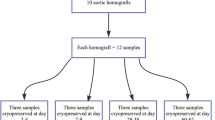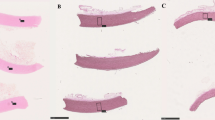Abstract
In regard to evaluating tissue banking methods used to preserve or otherwise treat (process) soft allograft tissue, current tests may not be sufficiently sensitive to detect potential damage inflicted before, during, and after processing. Using controlled parameters, we aim to examine the sensitivity of specific biomechanical, electrical, and biological tests in detecting mild damage to collagen. Fresh porcine pulmonary heart valves were treated with an enzyme, collagenase, and incubated using various times. Controls received no incubation. All valves were cryopreserved and stored at −135 °C until being rewarmed for evaluation using biomechanical, permeability, and cell viability tests. Statistically significant time dependent changes in leaflet ultimate stress, (p = 0.006), permeability (p = 0.01), and viability (p ≤ 0.02, four different days of culture) were found between heart valves subjected to 0–15 min of collagenase treatment (ANOVA). However, no statistical significance was found between the tensile modulus of treated and untreated valves (p = 0.07). Furthermore, the trends of decreasing and increasing ultimate stress and viability, respectively, were somewhat inconsistent across treatment times. These results suggest that permeability tests may offer a sensitive, quantitative assay to complement traditional biomechanical and viability tests in evaluating processing methods used for soft tissue allografts, or when making changes to current validated methods. Multiple test evaluation may also offer insight into the mechanism of potential tissue damage such as, as is the case here, reduced collagen content and increased tissue porosity.






Similar content being viewed by others
References
American Association of Tissue Banking (AATB) (2012) Standards for tissue banking, 13th edn. McLean, Vurginia
Brockbank KG, Dawson PE (1993) Influence of whole heart postprocurement cold ischemia time upon cryopreserved heart valve viability. Transpl Proc 25:3188–3189
Brockbank KG, Carpenter JF, Dawson PE (1992) Effects of storage temperature on viable bioprosthetic heart valves. Cryobiology 29:537–542
Brockbank KG, Heacox AE, Schenke-Layland K (2011a) Guidance for removal of fetal bovine serum from cryopreserved heart valve processing. Cells Tissues Organs 193:264–273. doi:10.1159/000321166
Brockbank KG, Rahn E, Wright GJ, Chen Z, Yao H (2011b) Impact of hypothermia upon chondrocyte viability and cartilage matrix permeability after 1 month of refrigerated storage. Transfus Med Hemother 38:387–392. doi:10.1159/000334595
Brockbank KG, Wright GJ, Yao H, Greene ED, Chen ZZ, Schenke-Layland K (2011c) Allogeneic heart valve storage above the glass transition at −80 degrees C. Ann Thorac Surg 91:1829–1835. doi:10.1016/j.athoracsur.2011.02.043
Brockbank KG, Chen Z, Greene ED, Campbell LH (2015) Vitrification of heart valve tissues. Methods Mol Biol 1257:399–421. doi:10.1007/978-1-4939-2193-5_20
Dahl SL, Chen Z, Solan AK, Brockbank KG, Niklason LE, Song YC (2006) Feasibility of vitrification as a storage method for tissue-engineered blood vessels. Tissue Eng 12:291–300. doi:10.1089/ten.2006.12.291
Elder E, Chen Z, Ensley A, Nerem R, Brockbank K, Song Y (2005) Enhanced tissue strength in cryopreserved, collagen-based blood vessel constructs. Transpl Proc 37:4625–4629. doi:10.1016/j.transproceed.2005.10.033
Frank EH, Grodzinsky AJ, Phillips SL, Grimshaw PE (1990) Physiochemical and bioelectrical determinants of cartilage material properties. In: Mow VC, Wood DO, Woo SL (eds) Biomechanics of diarthrodial joints, vol 1. Springer, New York, pp 261–282
Garcia AM, Frank EH, Grimshaw PE, Grodzinsky AJ (1996) Contributions of fluid convection and electrical migration to transport in cartilage: relevance to loading. Arch Biochem Biophys 333:317–325. doi:10.1006/abbi.1996.0397
Gu WY, Justiz MA, Yao H (2002) Electrical conductivity of lumbar anulus fibrosis: effects of porosity and fixed charge density. Spine 27:2390–2395. doi:10.1097/01.BRS.0000030196.66663.7E
Gu WY, Yao H, Vega AL, Flagler D (2004) Diffusivity of ions in agarose gels and intervertebral disc: effect of porosity. Ann Biomed Eng 32:1710–1717
Hinton RB, Yutzey KE (2011) Heart valve structure and function in development and disease. Annu Rev Physiol 73:29–46. doi:10.1146/annurev-physiol-012110-142145
Hu J, Gilmer L, Hopkins R, Wolfinbarger L Jr (1990) Assessment of cellular viability in cardiovascular tissue as studied with 3Hproline and 3Hinulin. Cardiovasc Res 24:528–531
Jackson A, Gu W (2009) Transport properties of cartilaginous tissues. Curr Rheumatol Rev 5:40. doi:10.2174/157339709787315320
Kuo J, Wright GJ, Bach DE, Slate EH, Yao H (2011) Effect of mechanical loading on electrical conductivity in porcine TMJ discs. J Dent Res 90:1216–1220. doi:10.1177/0022034511415275
Lee JM, Boughner DR (1981) Tissue mechanics of canine pericardium in different test environments. Evidence for time-dependent accommodation, absence of plasticity, and new roles for collagen and elastin. Circ Res 49:533–544
Lee JM, Courtman DW, Boughner DR (1984) The glutaraldehyde-stabilized porcine aortic valve xenograft. I. Tensile viscoelastic properties of the fresh leaflet material. J Biomed Mater Res 18:61–77. doi:10.1002/jbm.820180108
Mandl I, Maclennan JD, Howes EL (1953) Isolation and characterization of proteinase and collagenase from Cl. histolyticum. J Clin Investig 32:1323–1329. doi:10.1172/JCI102861
Maroudas A (1968) Physicochemical properties of cartilage in the light of ion exchange theory. Biophys J 8:575–595. doi:10.1016/S0006-3495(68)86509-9
Messier RH Jr, Bass BL, Aly HM, Jones JL, Domkowski PW, Wallace RB, Hopkins RA (1994) Dual structural and functional phenotypes of the porcine aortic valve interstitial population: characteristics of the leaflet myofibroblast. J Surg Res 57:1–21. doi:10.1006/jsre.1994.1102
Mochtar B, van der Kamp AW, Roza-de Jongh EJ, Nauta J (1984) Cell survival in canine aortic heart valves stored in nutrient medium. Cardiovasc Res 18:497–501
Mozaffarian D et al (2015) Heart disease and stroke statistics—2015 update: a report from the American Heart Association. Circulation 131:e29–e322. doi:10.1161/CIR.0000000000000152
O’Brien J, Wilson I, Orton T, Pognan F (2000) Investigation of the Alamar Blue (reszurin) fluorescent dye for the assessment of mammalian cell cytotoxicity. Eur J Biochem FEBS 267:5421–5426
Perie D, Iatridis JC, Demers CN, Goswami T, Beaudoin G, Mwale F, Antoniou J (2006) Assessment of compressive modulus, hydraulic permeability and matrix content of trypsin-treated nucleus pulposus using quantitative MRI. J Biomech 39:1392–1400. doi:10.1016/j.jbiomech.2005.04.015
Sacks MS, Schoen FJ, Mayer JE (2009) Bioengineering challenges for heart valve tissue engineering. Annu Rev Biomed Eng 11:289–313. doi:10.1146/annurev-bioeng-061008-124903
Schoen FJ, Levy RJ (1999) Founder’s award, 25th annual meeting of the society for biomaterials, perspectives. Providence, RI, April 28-May 2, 1999. Tissue heart valves: current challenges and future research perspectives. J Biomed Mater Res 47:439–465
Shoulders MD, Raines RT (2009) Collagen structure and stability. Annu Rev Biochem 78:929–958. doi:10.1146/annurev.biochem.77.032207.120833
Swartz MA, Fleury ME (2007) Interstitial flow and its effects in soft tissues. Annu Rev Biomed Eng 9:229–256. doi:10.1146/annurev.bioeng.9.060906.151850
Vesely I, Gonzalez-Lavin L, Graf D, Boughner D (1990) Mechanical testing of cryopreserved aortic allografts: comparison with xenografts and fresh tissue. J Thorac Cardiovasc Surg 99:119–123
Votteler M, Carvajal Berrio DA, Pudlas M, Walles H, Stock UA, Schenke-Layland K (2012) Raman spectroscopy for the non-contact and non-destructive monitoring of collagen damage within tissues. J Biophotonics 5:47–56. doi:10.1002/jbio.201100068
Wang L, Korossis S, Fisher J, Ingham E, Jin Z (2011) Prediction of oxygen distribution in aortic valve leaflet considering diffusion and convection. J Heart Valve Dis 20:442–448
Watts LK, Duffy P, Field RB, Stafford EG, O’Brien MF (1976) Establishment of a viable homograft cardiac valve bank: a rapid method of determining homograft viability. Ann Thorac Surg 21:230–236
Wolfinbarger L Jr, Brockbank KG, Hopkins RA (2004) Application of cryopreservation to heart valves. In: Hopkins RA (ed) Cardiac reconstructions with allograft valves, 2nd edn. Springer, New York
Wuensch E, Heidrich HG (1963) On the quantitative determination of collagenase. Hoppe-Seyler’s Zeitschrift fur physiologische Chemie 333:149–151
Acknowledgments
This research was supported by a Grant from the Scientific and Technical Affairs Committee of the American Association of Tissue Banks (to KGMB and AL-J) and National Institutes of Health Grants DE021134, DE018741, and AR055775 to HY, and a National Institutes of Health F31 predoctoral fellowship DE023486 to GJW.
Author information
Authors and Affiliations
Corresponding author
Ethics declarations
Conflict of interest
KGMB is an owner and employee of Tissue Testing Technologies, ZC, EDG, and LHC are employees of Tissue Testing Technologies. None of the other authors of this paper have any potential conflicts of interest that might be construed as affecting the conduct or reporting of the work presented.
Rights and permissions
About this article
Cite this article
Hepfer, R.G., Brockbank, K.G.M., Chen, Z. et al. Comparison and evaluation of biomechanical, electrical, and biological methods for assessment of damage to tissue collagen. Cell Tissue Bank 17, 531–539 (2016). https://doi.org/10.1007/s10561-016-9560-y
Received:
Accepted:
Published:
Issue Date:
DOI: https://doi.org/10.1007/s10561-016-9560-y




